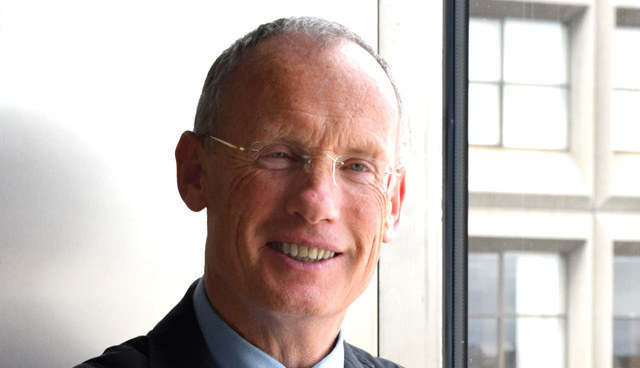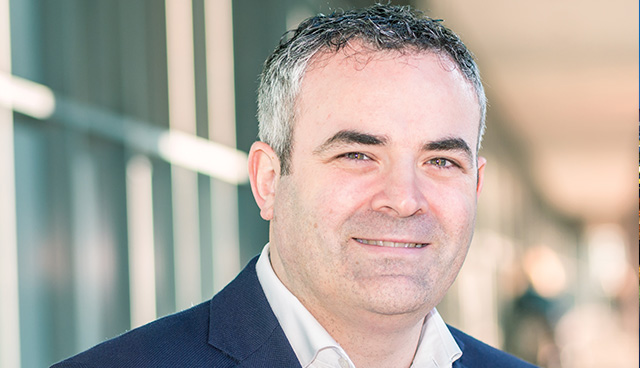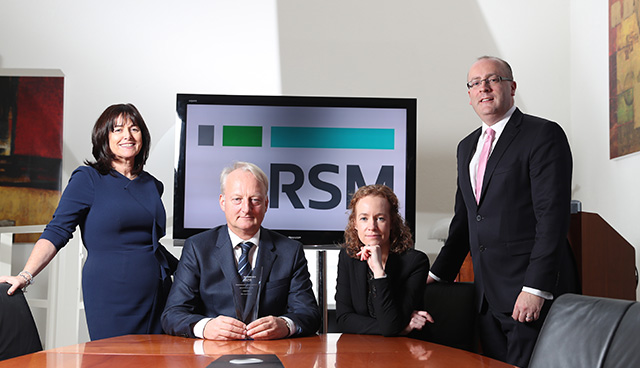Holistic talent management


Talent management is a key component of the Civil Service’s overall People Strategy, and, from that perspective, is a priority for David Cagney. Ciarán Galway visits Government Buildings to discuss talent management with the Chief Human Resources Officer for the Civil Service.
“On its own, talent management is something that’s nice to have, but it should be integrated with workforce planning,” says David Cagney, opening the interview. “It needs to recognise learning and development. It needs to be part of performance management system,” he explains, referencing the significance of strategic human resource planning within the Civil Service.
“It also needs to contribute to the business. If we invest as significantly as we have in talent management, then we need to evaluate its effect on the efficiency and effectiveness of our delivery models. One of the components of the Strategy is that we want to show how all HR interventions, and talent management is one of them, deliver real value to the business.”
Cagney’s current strategic priorities, as set out in the People Strategy, concern planning for the workforce of the future, being an employer of choice and supporting and valuing managers as people developers. Each of these, to varying degrees, requires leadership as well as new and innovative ways of thinking.
Talent management programmes have been introduced at senior management level (assistant secretary and principal officer levels) which are designed to ‘grow’ leaders. It is intended that this strategy will then “cascade that down through the varying grades as we progress and learn from the initiatives that we are currently rolling out”.
Rationale
Effective talent management is informed by a recognition that in coming years, the challenges faced Civil Service will change and become radically different. Such changes will be “accentuated by the movement out, through natural wastage and retirement, of good people with a lot of experience”.
In recognising this, the Human Resources Division’s focus is on ensuring a pipeline of talent availability at all levels. Over time, therefore, talent management programmes will be rolled out to feeder grades – assistant principal officer, higher executive officer, administrative officer and the Civil Service graduate programme.
With implementation imminent at principal officer grade, having learned from the pilot, the programme has been adapted and the potential cadre of staff who can apply for it widened. “These are demanding programmes, the people who commit to them are expected to put an awful lot of time and energy into their participation. They also sign up for the possibility of being moved to areas within the Civil Service where their own talents can be used effectively and where there are developmental opportunities for them,” Cagney indicates.
“One of the concepts we have introduced recently in relation to senior management promotions is that we want people with a wider variety of experience than have traditionally been sought within the Civil Service. For example, we would like people to have worked in more than one department, we would like there to be an international dimension to the civil servant’s role. It doesn’t necessarily mean that they have to work abroad, but they should have some experience not solely and exclusively confined to the Republic.”
Indeed, the intention is to recognise talent at all levels and acknowledge the fact that the Civil Service is likely to lose in-and-around 10,000 experienced people over the next number five-to-10 years. “It is really important that we plan for that loss of experience, talent and knowledge by ensuring that there are talented civil servants, at all levels, capable of filling those positions,” outlines Cagney.
“The investment that we put into that pipeline means that we have a greater opportunity to ensure that the management of the Civil Service is fit for purpose and capable of addressing the challenges of the day. These positions for the most part, will be advertised externally, but the success rate of our own people in external competitions is very high, so it’s an investment in the future of the Civil Service.”
‘Future leaders’
The Senior Public Service (SPS), otherwise defined as the secretary general and assistant secretary cadre of the Civil Service, is actively being encouraged to perceive itself as a Civil Service ‘corporate resource’, rather than a particular departmental resource, although in reality most of these officials will have spent their careers in one or maybe two departments.
“We see leadership as being distributed and cascaded across the Civil Service. We see everybody as a leader and everybody as a talent that needs to be nurtured and developed…”
“The concept behind SPS mobility is that, where vacancies arise at that level, the opportunity to transfer into these roles is offered to other assistant secretaries. It is an opportunity to bring fresh thinking, developmental opportunity and also part of our overall talent management succession planning strategy as well – that within that cadre, we build up a wider understanding and appreciation of the challenges across the Civil Service,” Cagney clarifies.
However, he is keen to avoid a situation where talent management is simply seen as a pipeline for promotional outlets. “While it clearly has a huge contribution to make to that end, we see leadership as being distributed and cascaded across the Civil Service. We see everybody as a leader and everybody as a talent that needs to be nurtured and developed,” he asserts.
“One of the key priorities in our People Strategy is being an employer of choice and, aligned to that is valuing managers, thereby creating the context in which civil servants can give their very best. That’s a really important component of the strategy in terms of the outputs that we’re looking for.”
It is intended that high-quality workforce plans will not merely inform recruitment campaigns but also the learning and development strategies for the various departments and offices. Simultaneously, through a virtuous circle, they should enhance engagement with managers through the performance management process.
In relation to the more junior grades, the Human Resources Division has taken “a completely different view of learning and development”. “Hitherto, it was largely organised within departments and offices. What we have now done is to create a new learning and development delivery system called OneLearning and we have designed a whole range of courses, based upon input from across the Civil Service relating to what type of learning and development would be appropriate to a wider variety of grades within the civil service, in terms of skills, knowledge and expertise.
“That has been rolled out since last September and it is focused very much on civil servants at all levels, but particularly at junior levels. We are working towards a situation where the performance management conversation influences the direction of travel that civil servants may take with regard to training interventions to advance their own career.”
HR technology
Cagney illustrates that the delivery of learning and development will be significantly enhanced by the roll out of the Learning Management System, which is currently project management stage. “That will actually be a game-changer in terms of the way people access learning and development, and the opportunities that are available to people. It will bring the Civil Service very much in line with best practice is similarly sized organisations in Ireland and across the globe.
“Technology very definitely enhances people management. We would ultimately see ourselves developing a human capital management (HCM) approach and we are currently looking at the HR management system that we have, which has served its purpose in many respects. For instance, it facilitates the 360-degree evaluation of assistant secretaries and their performance management process, but we would like to go a lot further.
“Over time, we will be looking at the potential for a new system which enhances the ability of technology to facilitate better management of people. One of our targets would be to have the kind of information that managers would need and should have, easily accessed from their desks via technology, which is quite difficult to do with current systems.”
Challenges
The Chief Human Resources Officer contends that, aside from size and scale, the talent management challenges faced by the Civil Service are not dissimilar to those encountered by other organisations. “We know that the world of work is likely to change quite radically over the coming years, so we need to plan for the future rather than building constructs that make sense today. We know we need to be a lot more innovative – what does that mean?
“We should be solution finders as well as deliverers of service. That challenge is not just unique to the senior echelons within the Civil Service, we all have a huge part to play in ensuring that both government and the public receive the service that is appropriate to the demands and expectations at the time.”
In addition, one of Cagney’s most significant challenges is determining how contribution to business is evaluated. “We can evaluate a lot of this stuff in a qualitative sense, but we also need to find a way of evaluating it in a quantitative sense. That again, is a justification for the investment that we make in talent management,” he indicates.
Retention
Currently, retention is not regarded as a significant problem, beyond the approaching ‘retirement cliff’. At the same time, there is an acknowledgment that the way people approach work now is very different to 20 or 30 years ago.
“There is a big indication that we are a moving away from the concept of a ‘career for life’, which would have been a value proposition that most civil servants would have engaged with when they began their career. For example, in the IT space, we’re aware that many people are not so much interested in working for company A or company B but want to work on project X or project Y and will move for the interest that they have in that work as opposed to the company.
“We know that the Civil Service is going to face such challenges, particularly as the economy improves. While we don’t have a huge [talent] haemorrhage at this moment in time, we want to avoid the possibility of this arising. One of the ways of doing that is to ensure that learning and development opportunities, as well as a high quality of working life, are available to all civil servants. Likewise, we encourage them to see that they are meaningfully contributing to society and that, as an organisation, we recognise that this contribution needs to be supported by our own structures.”
Workplace wellbeing
While developing the People Strategy, one key action was to focus more on wellbeing. This, according to Cagney, is a recognition that the quality of the experience in working life is a major contributor to the quality of output. “Our staff engagement survey saw us score quite highly on wellbeing, but the real challenge for us now is to maintain that score and, in fact, increase it,” he advises.
Drawing on the example of organisations like Ibec, Cagney suggests that the introduction of a quality mark around wellbeing indicates its criticality in relation to productivity. “They see it as an investment towards securing the bottom line. We would see it as an investment in our people to ensure that their experience of working life is conducive to them giving their best.
“It’s a recognition too that people don’t just bring a desire to work to the workplace, they also bring their personal challenges and dispositions. The work environment needs to actually recognise that situation and understand that people will occasionally need a greater degree of flexibility in relation to their own perception of work challenges.
“I think it’s good for everybody. The Chartered Institute of Personnel Development would see it as a key differentiator between good and bad employers, and we see it, in many respects, as the bedrock on which we would build and increase our quality of service to the Government and the citizen.”
One of the initiatives in the People Strategy is to recognise that line managers should manage, in a holistic sense, the performance of their people, cognisant of the life challenges that each individual experiences. “We expect our line managers to work with individuals and assist them through those particular challenges. Then, in almost all departments, you will see initiatives such as yoga, boxercise, mindfulness and different interventions, because not everyone is looking for the same thing in a wellbeing context.
“In conjunction with Healthy Ireland, we are developing an initiative which we will roll out across the Civil Service under the auspices of the Strategy, recognising the Government’s commitment to a healthy workplace. The bottom line is that it’s mutually beneficial – it’s good for the customer, the civil servant and society. When you put all of those goods together, it’s something that is certainly worth doing.”
Bringing the interview to its conclusion, Cagney summarises: “My vision for HR, and talent management as a key component of it, is that it contributes to the business of the Civil Service and that we can demonstrate in both qualitative and quantitative terms that impact. Otherwise we shouldn’t be doing this stuff.”
David Cagney
Chief Human Resources Officer for the Civil Service
David was appointed Chief Human Resource Officer for the Civil Service in September 2015. His remit includes the development and implementation of HR policies in the civil service including workforce planning and policies on recruitment; promotion; mobility; secondment, redeployment and performance management. It also includes the Senior Public Service.
Prior to joining the Civil Service, he held the position of Director of Human Resources at the Dublin Institute of Technology. David has previously worked with An Post, Ibec and with the Local Government Staff Negotiations Board in a variety of HR roles. He also served as a Vice Chairman of the Employment Appeals Tribunal from 2007 to 2010.
A graduate of University College Dublin, he was called to the bar in 1993.





